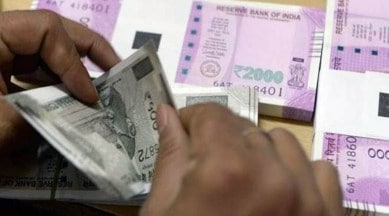Credit card NPAs rise Rs 765 crore in 9 months to Rs 3,887 cr amid RBI caution
However, credit card NPAs made up just 2.16 per cent of the total credit card outstanding or loan exposure as of December 2022, a marginal increase from 2.11 per cent on March 31, 2022.

Bad or non-performing assets (NPA) in banks’ credit card segment jumped by Rs 765 crore, or 24.5 per cent, to Rs 3,887 crore in the April-December period of 2022, according to a reply by the Reserve Bank of India (RBI) to an RTI query by The Sunday Express.
However, credit card NPAs made up just 2.16 per cent of the total credit card outstanding or loan exposure as of December 2022, a marginal increase from 2.11 per cent on March 31, 2022.
monthly limit of free stories.
with an Express account.
Though the credit card NPA figure is much smaller when compared to the total outstanding of banks, the rising NPA trend is becoming a source of worry for the RBI. It is learnt that the central bank has cautioned banks on unsecured loans such as personal loans and credit cards.
The banking system’s credit card outstanding was at Rs 1.8 lakh crore as on December 30, 2022. The latest RBI data shows that the banking sector’s credit card loan exposure stood at Rs 2 lakh crore as on April 21, 2023. This is 1.5 per cent of their total loan book.
The RBI provided credit card NPA data for the nine months ended December 31, 2022, as data for the fourth quarter ended March 2023 was being compiled.
Banks charge a high interest rate — around 38-42 per cent — on outstanding dues after the grace period. According to the RBI’s State of Economy article, published in the April 2023 monthly bulletin: “Delinquencies are reducing in the 90+ days past due bracket across all categories of consumer credit, barring credit cards and education loans.”
The article was prepared by RBI Deputy Governor Michael Patra and other central bank officials.
In credit card accounts, the amount spent is billed to users through a monthly statement with a definite date for repayment. Banks give an option to the users to pay either the full amount or a fraction of it, i.e., the minimum amount due, on the due date and roll over the balance to the subsequent months’ billing cycle.
A credit card account will be treated as a non-performing asset if the minimum amount due, as mentioned in the statement, is not paid fully within 90 days from the payment due date mentioned in the statement.
Banks can report a credit card account as ‘past due’ to credit information companies (CICs) or levy late payment charges only when a credit card account remains ‘past due’ for more than three days. The number of ‘days past due’ and late payment charges is computed from the payment due date mentioned in the credit card statement.
If there is default in unsecured loans, banks do not have any recourse as there is no collateral involved. This could pose a risk to banks’ asset quality.
An unsecured loan is one where a borrower is not required to provide any collateral, or security, to a lender in order to avail them. These loans are offered based on the creditworthiness of borrowers.
“RBI is especially monitoring those segments of credit cards where outstanding and overdues are high,” according to a person familiar with the matter.
Sources say the RBI is also considering increasing the risk weights on unsecured personal loans, including credit cards. The central bank did not respond to an email seeking comment.
Risk weight is the amount of capital that the lender has to set aside for every loan offered. An increase in risk weight will mean banks will have to make higher capital provisions for every loan.
Currently, the risk weight for consumer credit, including personal loans is 100 per cent. For credit card receivables, it is 125 per cent. Over the last few quarters, consumer durables and credit card loans have grown at a faster pace, driven by higher consumer spending.
As on April 21, 2023, while consumer durables loans registered a year-on-year growth of 30.8 per cent, credit card outstanding rose by 29.7 per cent, RBI data showed. “The rise in credit card outstanding is because the overall economic growth has improved, consumer demand has increased and also as the number of credit cards has risen. We should be worried only if credit card defaults go up,” said a private sector lender.
In FY2023, the number of credit cards in the system increased to 8.53 crore from 7.36 crore in FY2022.
Fitch Ratings, in a recent report, said credit card lending and personal loans exposure rose to 10.2 per cent of system loans by FY23, from 7.5 per cent at FY18.
“We view such unsecured categories as most vulnerable to potential stress, though exposures among our rated entities remain manageable, and improvements in risk controls and loan-book granularity should help to reduce risks associated with any future asset-quality deterioration relative to previous cycles,” said Saswata Guha, Senior Director (Banks), Fitch Ratings, in the report. He expects tighter regulatory supervision to slow unsecured lending in the year ahead.